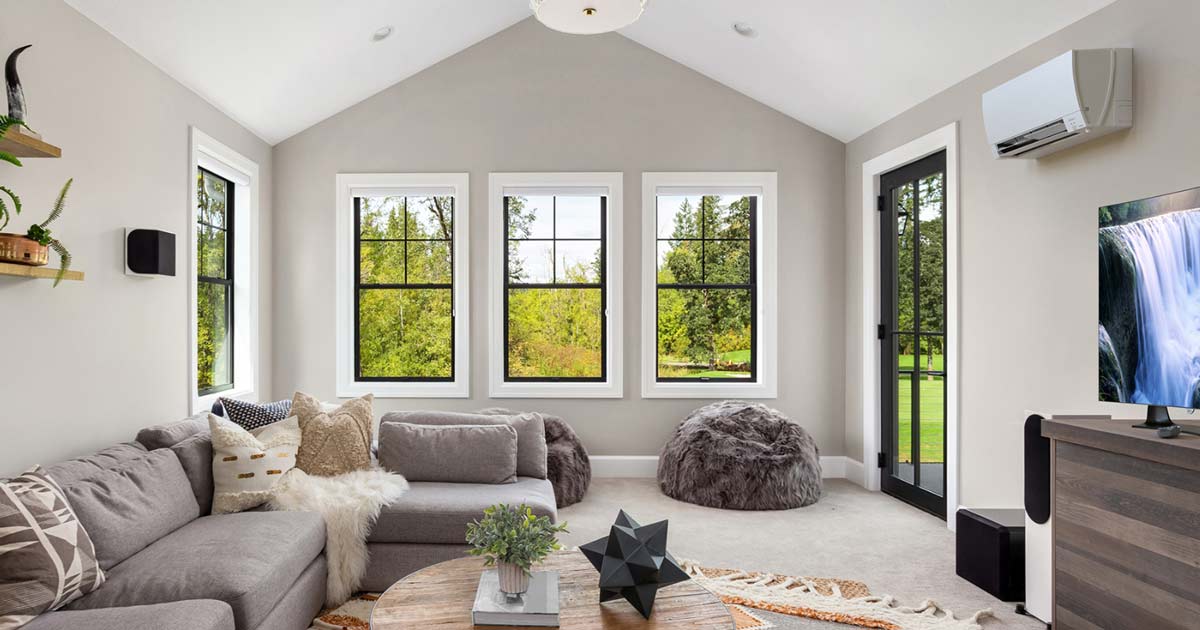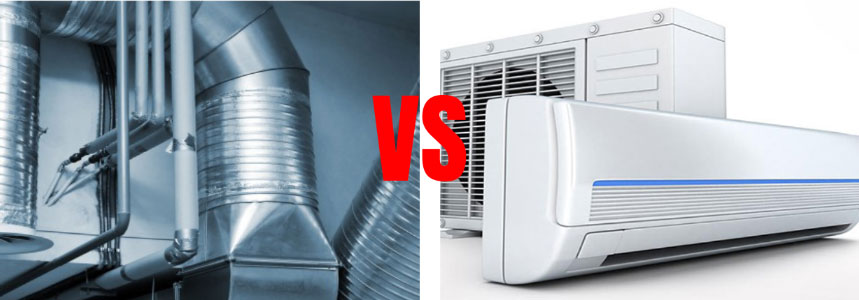Leonard Splaine Ductless Heating & Cooling In Northern VA

Ductless HVAC
There’s nothing that feels quite as nice as when your home or workspace is at the exact perfect temperature that you want it to be. There are various ways to achieve this, and one of the best ways and an increasingly popular one is with the ductless HVAC or mini-split systems.
At one point, knowledge of HVAC (Heating, Ventilation, and Air Conditioning) was limited to only industry experts and those wealthy enough to afford it. But nowadays, the HVAC industry has become much more accessible with an abundance of "what is HVAC" inquiries on Google.
The term "HVAC" has become widely known as a general term for air conditioning. However, what does it actually mean and how does it factor into your home or business? Is it just for cooling or does it also involve heating? Is there any difference between HVAC and air conditioning systems?
Well, as we progress into a future of ever-improving air control systems for places of all shapes and sizes, it is essential to ask these important questions. Because, ultimately, the only way to make a fully educated decision is to be, well, truly informed. This is true even when there is a plethora of options available.
In this post, we shall define HVAC and air conditioning, break down the differences between ductless vs ducted HVAC and learn how ductless HVAC actually work.
What is Ductless HVAC?
Let’s start right off with an important question: “What does HVAC stand for?”. HVAC stands for heating, ventilation, and air conditioning. It is responsible for heating and cooling a building. It’s also a source of proper ventilation, allowing for moisture to escape.
Depending on their design and the locations they're used in, HVAC systems can come in a variety of sizes and shapes and offer a number of benefits. The following are all possible combinations of units:
- Boilers
- Air conditioning units
- Ducts and moisture vents
Not all HVAC units are air conditioning units, even though AC units are included under the HVAC umbrella. As outlined above, what’s important to understand is that it’s actually a larger term. Think of it as an umbrella term that applies to all sorts of interrelated air control systems.
So what exactly is Ductless HVAC? You guessed it – no ductwork.
A ductless mini split system is essentially a heating and cooling solution that requires no ductwork. It consists of one outdoor and one indoor unit, which are connected by refrigerant tubing and electrical wiring. The indoor unit is typically wall-mounted, and it disperses heated or cooled air right into the living space. This is referred to as a single-zone system and is intended to provide comfort to a certain area. For larger homes, a multi-zone system can be installed and this consists of one outdoor unit and up to five indoor units to guarantee comfort throughout the entire house.
With different designs of indoor units available and the fact that only a hole in the wall is required for the wiring and refrigerant line, ductless HVAC systems are some of the most convenient and flexible systems to install.
Ducted vs Ductless HVAC

Although ducted HVAC systems have been the norm for many homeowners, ductless mini-split systems have become increasingly popular in recent years. If you're considering replacing your existing system or getting a new one, it's important to weigh the pros and cons of a ductless HVAC system against those of a ducted HVAC. Both systems offer different benefits, so it's important to understand which would be the best fit for your home.
When it comes to ensuring our homes are comfortable, efficiency should be the top priority. By finding the most efficient solution, we can reduce costs associated with utilities. Besides efficiency, other elements to think about when choosing an HVAC system include air quality, appearances, installation expenditure, and ease of operation.
Ductless mini splits are incredibly versatile and meet all these criteria. However, those who want a more all-encompassing system may opt for a ducted heat pump. Ultimately, when choosing between a ductless vs. ducted HVAC, personal preferences will be the most significant factor.
What’s the difference between ductless air conditioning and ducted air conditioning?
In a ducted air conditioning system, sheet metal ducts are placed within the walls and ceilings of your home. These same ducts are used to distribute both heated and cooled air from the central air conditioning unit or furnace through the ducts, out of the vents and into each room.
Ductless mini split systems are also commonly referred to as ductless heat pumps, mini splits, split-type air conditioners, ductless systems, and ductless air conditioners. Unlike a ducted system, ductless mini splits control temperatures for individual rooms instead of the whole house. Depending on your HVAC needs, they can provide both heating and cooling.
Ductless mini split systems are made up of two components: a condenser and an air-handler. The condenser, or outdoor unit, houses the compressor, while the air-handler resides inside the home. Each room or area requires an air-handler, which is roughly three feet long by one and a half feet high. Smaller than traditional ducted systems, they require minimal installation and can be mounted almost anywhere.
When to choose ducted air conditioning
The space has existing ducts
If ductwork is already in place and in a good state, many specialists suggest opting for a ducted system. The installation is merely a case of connecting the new unit to the current ventilation. This is faster and more cost effective.
Humidity is a concern
Ducted air conditioning systems have the advantage of better controlling humidity, due to their air handlers having the necessary mechanisms to remove and drain away excess moisture from the air. In contrast, ductless air conditioning systems lack these mechanisms, making them less effective at humidity control.
You want better air flow
Ducted air conditioning systems promote better air flow as they are able to move air throughout the space. In comparison, ductless air conditioning systems cool each room separately, resulting in less air movement and potentially leaving some areas with stagnant air and air pressure issues.
Aesthetic concerns
Aesthetics can be a major factor when it comes to selecting an air conditioning system for a home. Ducted air conditioning systems offer the advantage of having the equipment hidden away in the walls or crawlspaces, whereas ductless systems require the air handler boxes to be mounted on the wall or ceiling of each room, which may not always be desirable from an appearance standpoint.
When to choose ductless air conditioning
There's no room for ducts in the walls or ceilings
If you live in those big and modern apartments and don't want to sacrifice those stunning high ceilings to install air conditioning ducts, then ductless air conditioning is the ideal solution. It provides an alternative to traditional ducts, so that you can preserve the beauty of your high ceilings.
You're adding a room to an existing space
Including a new room to an existing space or adding cooling to an area like a garage or work room may be expensive or challenging to achieve by connecting to your existing system, or it may have insufficient capacity to cool the additional area. Rather than replacing the system, you could supplement it with a small ductless air conditioning system only for the new space. This is commonly employed even in fresh construction in order to provide zoned cooling for sections that are not often used.
You want to decrease dust
Since forced air is not traveling throughout the space via ducts where dust can collect, there is less dust introduced to your rooms.
You want multiple cooling zones
Ductless air conditioning systems are beneficial in that each room has its own air handler, enabling you to modify the temperature for different needs. For instance, you can keep the living room cooler while raising the temperature in the bedroom where the baby is sleeping.
You want quick and easy installation
Other HVAC systems such as ducted heat pumps, can take a while and require extensive construction work to install. Mini split systems, however, are much faster to set up and are much less intrusive. This makes them a great choice for adding air conditioning to older homes that don't have existing ductwork. Installation is simple as it just requires a three-inch hole going through the wall for the connection between the indoor and outdoor units. Plus, there's no need to rebuild walls around the ductwork or lose any floor space. This makes the installation process much easier and quicker, often taking just a couple of days. This is one of the main reasons why mini split systems are an excellent choice for replacing window units.
You want need increased energy efficiency
Ducted systems are known to be inefficient in terms of energy loss. Heat escapes through the ducts as it is spread throughout the home. Mini splits, on the other hand, don't use ducts, meaning they are not affected by this type of energy depletion. Old-fashioned ducted systems can only be turned on or off, which can be wasteful in terms of power consumption. To be more energy-efficient, ductless units are fitted with inverter-driven compressors. These compressors vary their speed depending on the needs of the system, thus conserving energy. This means that ductless mini splits can decrease home heating expenses and reduce your energy bills.
You want a highly flexible design
Ductless mini splits offer homeowners a lot of flexibility when it comes to their heating system. With customizable placement options, the units can be suspended from a ceiling, mounted into drop ceilings, affixed to a wall, or placed on the floor. Moreover, the connecting conduits can extend up to 50 feet from the indoor evaporator, allowing homeowners to position the outdoor unit away from the main living area and resulting in a minimally-intrusive system. This is also one of the quietest heating systems available as it operates at a low sound levels. Furthermore, thanks to the 'zone' feature, homeowners have the ability to only heat certain rooms when they are occupied, therefore minimizing utility costs. All in all, ductless mini splits give homeowners much more control of their existing interior design.
You want a long lifespan
Opting for a long-term heating and cooling solution may help you avoid unnecessary repairs and visits from contractors. Mini split systems can provide up to two decades of use if kept in good condition. This may help save you from the hassle of work and costs associated with frequent maintenance.
Looking for a Ductless HVAC System or Need to Service Your Ductless Systems Heat Pump?
Are you interested in the convenience and flexibility of a ductless HVAC system, or do you need your Ductless HVAC repaired or serviced? Then give our team of experts at Leonard Splaine a call today. We will find the best solution for your needs!

How Does Ductless HVAC Work?
Prior to the invention of mini splits, all whole-house HVAC systems contained ductwork, they were expensive to operate, and could only deliver cooling or heating.
Mini splits changed all that.
Ductless small split heat pumps essentially pump heat from indoors to outdoors (for cooling) and from outdoors to indoors (heating). They are able to be so energy-efficient because they only transfer heat between two spaces rather of producing it, like a furnace burning natural gas would.
A refrigeration cycle serves as the foundation for the basic operation of these split system mini splits. The compression and expansion of refrigerants (such as R410A, R22, and others) is used in this well-known thermodynamic cycle to move heat.
How Can A Mini Split Provide Cooling?
Here is the fundamental operation of a ductless mini split cooling part in the simplest terms:
- Through refrigeration lines, compressed refrigerant that is liquid at low pressure travels from the outdoor unit to the indoor unit.
- The interior air handler's evaporator cooling coils are where liquid refrigerant enters and expands, turning from liquid to gas. This process cools the coils since it is endothermic from a thermodynamic standpoint.
- Warm indoor air is drawn in by an indoor air blower and forced over these chilly coils. This reduces air temperature and eliminates humidity (air moisture is condensed on these cold coils). We experience the indoor air handler blowing cold air as this cool, dry air is emitted into our home.
- Through the refrigerant lines that link the two units, gaseous refrigerant (high pressure) now returns to the outside unit. On this sketch, this is indicated with a pink line (cold vapor).
- The refrigerant is compressed and reconverted to liquid in the outside unit (using the tiny split compressor). It produces a lot of heat because it is an exothermic reaction. Consequently, outdoor units may be very warm. Basically, the compressor's purpose is to extract the heat that has been accumulated from this refrigerant.
- Refrigerant lines carry the refrigerant back into the interior unit once it has reached a cool liquid state once more.
- Once more, the tiny split refrigeration cycling has just begun. This cycle keeps repeating till we reach the desired indoor temperature.
Okay, this is the cooling part. How is it possible for a mini split system to also heat? At first, it appears to be paradoxical. Now let's explain how split heating process operates:
How Can A Mini Split Provide Heating?
For the heating process to occur, the refrigeration cycle, described above, is just reversed.
The refrigerant flow is reversed in mini splits using a unique device called a reverse valve. That's it; you are now receiving heating instead of cooling.
As with a typical air conditioner, the refrigerant expands indoors to provide cooling and contracts outdoors to provide cooling while running (expelling heating). The mini split heat pump gathers all the heat that is present outside (the compressor expands, collecting the heat) and brings it inside when the reverse valve is turned on.
It may have occurred to you that the compressor's capacity to serve as an evaporator is the entire point of heating (capable of expanding the refrigerant gas).
Here is a step-by-step breakdown of how heating (rather than cooling) is achieved by switching the refrigerant flow in mini splits:
- A low-pressure liquid refrigerant is expanded by a compressor into a high-pressure gaseous refrigerant. You receive a heated refrigerant as a result of this.
- The indoor coils are warmed by hot refrigerant that is piped through them and circulated within.
- Warm air is blown into your house by a blower over these now-hot coils.
- The hot gas refrigerant is cooled and returned to a low-pressure liquid form throughout this procedure.
- Refrigerant lines carry this liquid refrigerant back to the outside unit.
- The heating cycle is finished when a compressor converts the cold liquid refrigerant into a hot gaseous refrigerant.
In this manner, a mini split can offer heating in the winter and cooling in the summer.
The most important thing to keep in mind is that even at low outdoor temperatures (below 50°F), the refrigerant has the ability to extract all of the heat that is present in outdoor air and transfer it indoors.
Mitsubishi Electric Ductless Heating: The Most Reliable Name in Ductless HVAC

Mitsubishi Electric was established in 1921 and produces an expansive array of electrical goods, for instance, heat pumps. It is renowned for its quiet models, a few of which run at sound levels as low as 19 decibels, comparable to someone whispering.
Mitsubishi Electric has pioneered the development of the dual barrier coating in its mini-split units, which helps to drastically reduce the amount of dust, oil, and other airborne particles that would otherwise reduce the efficiency of the units over time. In addition, their 3D i-See Sensor uses infrared sensors to detect the position of hot and cold spots in the room and then direct air towards them accordingly. The sensor can even detect if no one is in the room and shut off the unit, thereby saving energy.
What Does Mitsubishi Elite Diamond Contractor Mean?
An Elite Diamond Contractor designation signifies exceptional technical expertise and outstanding customer service. Our team undergoes specialized training certified by Mitsubishi. Technicians also receive hands-on training directly through Mitsubishi's certified programs.
What Makes Mitsubishi Electric Ductless Mini-Splits Different?
We love to use Mitsubishi Electric products when the job calls for one. What makes them different? The “zoned” solution. There is no need to heat and cool every room in your home all year long, when you only occupy a few rooms at a time. Don’t try to control your entire home with a single thermostat. Instead, achieve total comfort on demand while saving money and reducing your energy consumption at the same time with a zoned solution from Mitsubishi Electric.
Important Features of Mitsubishi Electric Heat pump
Here are some of the key features of Mitsubishi Electric heat pumps:
Mitsubishi Electric heat pump performance
Mitsubishi Electric air source heat pumps come in a variety of styles, ranging from low-cost to high-end. Most models are ENERGY STAR qualified and provide above-average to exceptional heating and cooling performance. Mitsubishi Electric heat pumps employ inverters to regulate conditioning automatically when temperature sensors detect even little changes. These inverters provide greater performance by delivering maximum power while using the least amount of energy. They take pleasure in providing quick, comfortable operation while maintaining minimal operating costs.

Mitsubishi Electric ductless systems come with a 12 & 12 limited warranty.
SEER ratings and cooling performance
When evaluating heat pumps, one performance number to consider is SEER, which evaluates cooling efficiency. The Air Conditioning, Heating, and Refrigeration Institute (AHRI) rates the efficiency of central air conditioning systems using a Seasonal Energy Efficiency Ratio (SEER), which means your heat pump is assessed similarly to an air conditioner. In general, the higher the SEER, the less electricity the system need to function. Mitsubishi Electric heat pumps provide excellent cooling efficiency, with up to 33.1 SEER, whereas other heat pumps on the market only provide 13 to 31 SEER.
HSPF ratings and heating performance
Another factor to consider when comparing heat pumps is the Heating Seasonal Performance Factor (HSPF). The higher the HSPF rating, the more efficient a heat pump is at heating, resulting in less energy utilized and greater overall energy savings. ENERGY STAR heat pumps must have an HSPF of at least 8.5, but heat pumps can have up to 14 HSPF. So, up to 13.5, Mitsubishi Electric HSPFs are considered high-end.
The kumo cloud® app
The kumo cloud® app, which is accessible on iOS, Amazon App Store, and Google Play, is used by all Mitsubishi Electric heat pumps. On your smartphone or tablet, you may manage temperature preferences for your heat pumps using the kumo cloud app. It also integrates with Google Assistant, Amazon Alexa, and IFTTT Applet Integration to control transfer fans and lighting. You can simply control temperatures, alter fan speeds, create modes and tailor schedules, monitor the status of your filters, and even manage the operation of third-party furnaces, boilers, heaters, humidifiers, and dehumidifiers using the app.
Find out more about Mitsubishi Electric HVAC products here.

Our 100% Satisfaction Guarantee
We're so confident you'll find us to be a company you can rely on for all your heating and air conditioning needs that we guarantee your complete satisfaction! Contact us today and experience the difference for yourself.
8 Maintenance Tips for Ductless Air Conditioners
Mini split and ductless air conditioners are both excellent options for home comfort. And just like any system, they need routine maintenance to maintain their effectiveness, durability, and optimal performance. Regular mini split maintenance is an affordable approach to help prevent bigger problems from occurring and may even spare you from significant repairs, which are normally much more expensive.
While there are some things that you will likely want to leave to a professional, there are a number of steps that you can take on your own to increase the functionality and lifespan of your system. Follow these 8 maintenance tips for ductless air conditioners to keep yours up to date and functioning properly.
Keep the Outside Clean
Making sure that your system is free of dust and dirt is one of the simplest things you can do to maintain it in the best condition. If you let dirt, dust, and other debris build up on the appliance, they can easily get inside the working parts and cause serious problems.
All you have to do to keep the outside of your ductless air conditioner clean is to remember to include it in your weekly dusting schedule. Simply use a moist cloth or a mild and secure chemical cleaner to clean the exterior. Ensure that the outdoor vents are free of debris, dust, and anything else that could clog the system and cause it to malfunction. This simple action can drastically cut down on future work and expenses.
Give it Some Space
Although ductless air conditioners take up less room than a typical air conditioning system, they nevertheless function best when given a lot of clear space to work in. The unit needs enough wall space to function properly. Make sure there isn't any huge furniture or artwork close by because these items can increase the buildup of dust and reduce the system's effectiveness. In addition to the walls themselves, you should leave the machinery with at least four feet of room on all sides. Avoid mounting picture frames or bookcases close to the ductless air conditioning unit. By making the area clear, you can ensure that your equipment is operating properly and avoid future problems.
Turn the System Off
Naturally, you'll need to do more than just clean the unit's outside if you want it to operate at its best. You need to confirm that all the components are turned off before you finish the more thorough cleaning of the interior of the unit. Bypassing this step, you run the risk of either breaking your device or, worse yet, hurting yourself by electrocution or other ways. Make sure the outdoor circuit switch is closed as well as all interior appliances. After you have turned off the appliance, be careful to give it some time to cool. Another risk is beginning too soon.
Remove the Filters
The filters in your system are some of the most important components for checking the functionality of your ductless air conditioner. Without proper maintenance, these filters can lead to decreased efficiency.
To clean your air filters, you will want to carefully remove them from the inside of the unit. Use a clean, dry cloth to gently wipe the filters clear of dirt and dust. You can check your manual for information about how often you should complete this task, though typically you will want to do this every four to six weeks for best results.
The filters are an important part in protecting the rest of your unit from dust accumulation and greatly contribute to the air quality in your home. At some point, you may need to replace the filters. If they cannot be sufficiently cleaned or are damaged, go ahead and replace them.
Clean the Coil and Condenser
You should also keep up with the exterior of your unit. You want to make sure that you routinely maintain the condenser and coils because they are crucial to the continuous operation of your system. This portion of your unit can easily become covered with outdoor dirt and debris, which will stop it from functioning. If neglected, it might stop the system from functioning entirely and do a lot of harm.
Make sure that every component is turned off before cleaning the device with a standard garden hose. Check the fins once you've finished this to make sure they didn't bend; if they did, you may use an alignment comb to make them straight again. Once the device has dried completely, you can use a hand duster to remove any remaining particles. To guarantee that your ductless air conditioner is routinely maintained, include this chore in your weekly cleaning schedule.
Clean the Pipes
The pipes, which connect the machine's outside and interior parts, are crucial for distributing heat or cold throughout your house. If left unattended, debris such as dirt and dust can amass and prevent air from entering your home. Obviously, this renders your ductless air conditioner inoperative. Furthermore, leaks might form in pipes, preventing appropriate operation. These pipes need to be checked periodically to make sure they are clear. Don't allow this duty slip through the cracks; it is a simple one to take care of when you are cleaning your air filters.
Check for Ice or Snow
When used for heating, ductless air conditioners can collect ice and snow, which can inhibit their ability to run efficiently. Regularly check the outside of your machinery for accumulation, and if you spot any, gently remove it from the unit. During the winter, you are likely running your unit frequently, and you will want to make sure that it is protected. Leaving this part of the unit covered in ice can quickly lead to expensive issues.
Call a Professional
While there is a lot that you can do on your own to keep your unit running properly, you will want to have a professional take a look to make sure that everything is functioning optimally. Before you hire an air conditioner technician, be sure to make sure they have positive reviews online and that they work for a reputable company.
A trained individual should look at a specific ductless air conditioner approximately once per year. During this visit, they will look at your drain hoses and ensure that they are not blocked, as well as identify refrigerant leaks. They will also investigate the electrical connections and run capacitors. If there are any issues with these components, the technicians will perform repairs or replacements to help your ductless air conditioning unit reach its optimal performance.
Performing a regular check can help prevent bigger issues later. While it might be tempting to do some of these things on your own, you might run the risk of making things worse and destroying it.
Expert Installation, Repair, and Maintenance of Ductless HVAC Systems
 At Leonard Splaine Heating & Cooling, we are experts in the installation, repair, and maintenance of ductless air conditioning and heating systems. With years of experience, our team of skilled professionals can help you choose the right system for your home and ensure that it's installed correctly for maximum efficiency and comfort. We also provide repair and maintenance services to keep your system running smoothly for years to come. Contact us today to schedule an appointment and start enjoying the benefits of energy-efficient and effective ductless HVAC technology in your home!
At Leonard Splaine Heating & Cooling, we are experts in the installation, repair, and maintenance of ductless air conditioning and heating systems. With years of experience, our team of skilled professionals can help you choose the right system for your home and ensure that it's installed correctly for maximum efficiency and comfort. We also provide repair and maintenance services to keep your system running smoothly for years to come. Contact us today to schedule an appointment and start enjoying the benefits of energy-efficient and effective ductless HVAC technology in your home!
We are the expert solution to all your HVAC problems! We solve problems and deliver solutions like no other HVAC company can!

We Are the Expert Solution to All Your HVAC & Home Comfort Needs
Take it from our customers: we solve problems and deliver solutions like no other HVAC company can. Contact us today!

